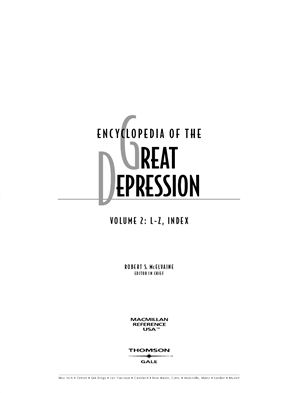Thompson, 2003. - 1134 pages.
Grade 9 Up–This comprehensive, accessible set will serve as a useful supplement for research. Myriad aspects of the crisis are covered in almost 550 alphabetically arranged, cross-referenced articles written by hundreds of inteational scholars. About 200 of the articles are biographies. Topics are easily located via a practical outline in volume one listing entries under categories such as "Agriculture," "Intellectual Trends and Developments," "Inteational Situation," "New Deal," and "Women and Gender." Article length varies, with most being a page or slightly longer; FDR's entry is 10 times that. Large black-and-white archival photographs, several by Dorothea Lange, are judiciously placed throughout. More straightforward and drier than James Ciment's Encyclopedia of the Great Depression and the New Deal (Sharpe Reference, 2001), which features primary-source documents, and without as much intrinsic appeal as Depression America (Grolier, 2001), this is nonetheless a worthy resource.
Grade 9 Up–This comprehensive, accessible set will serve as a useful supplement for research. Myriad aspects of the crisis are covered in almost 550 alphabetically arranged, cross-referenced articles written by hundreds of inteational scholars. About 200 of the articles are biographies. Topics are easily located via a practical outline in volume one listing entries under categories such as "Agriculture," "Intellectual Trends and Developments," "Inteational Situation," "New Deal," and "Women and Gender." Article length varies, with most being a page or slightly longer; FDR's entry is 10 times that. Large black-and-white archival photographs, several by Dorothea Lange, are judiciously placed throughout. More straightforward and drier than James Ciment's Encyclopedia of the Great Depression and the New Deal (Sharpe Reference, 2001), which features primary-source documents, and without as much intrinsic appeal as Depression America (Grolier, 2001), this is nonetheless a worthy resource.

